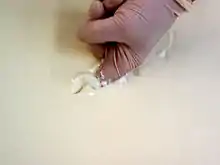Curdling
Curdling is the breaking of an emulsion or colloid into large parts of different composition through the physio-chemical processes of flocculation, creaming, and coalescence.[1] Curdling is purposeful in the production of cheese curd and tofu; undesirable in the production of a sauce, cheese fondue or a custard.[1]
.jpg.webp)
Method
In curdling, the pH of the milk decreases and becomes more acidic.[1] Independently floating casein molecules attract one another, forming "curdles" that float in a translucent whey.[1] At warmer temperatures, the clumping reaction occurs more quickly than at colder temperature.[1] Curdling occurs naturally if cows' milk is left open in a warm environment to air for a few days.
Cheese and tofu

.JPG.webp)
Milk and soy milk are curdled intentionally to make cheese and tofu by the addition of enzymes (typically rennet), acids (including lemon juice), or various salts (magnesium chloride, calcium chloride, or gypsum); the resulting curds are then pressed.[2]
Egg sauces
In hot preparations emulsified with eggs like hollandaise and custard, curdling is the undesirable result of overheating the sauce. Sauces which contain starch curdle with more difficulty.
In cold sauces like mayonnaise as well as in hot sauces, too large a ratio of fat to egg may also cause curdling.
Milk sauces
In sauces which include milk or yogurt, overheating often causes curdling. The higher the fat content, the less likely curdling is. Strained yogurt used in sauces also curdles only with difficulty.
Coffee
When a plant based milk such as soya milk is added to coffee, curdling can sometimes occur. To help prevent this manufacturers sometimes add acidity regulators.[3]
Cheesecake
When making cheesecake, if water is added to the cream cheese during the combining period, it will curdle.
Bibliography
- Harold McGee, On Food and Cooking: The Science And Lore Of The Kitchen, 1984–2004.
- Bethany Moncel "Why Does Milk Curdle". Foodreference.about.com.
References
- "Why does Milk Curdle?". www.scienceofcooking.com. Retrieved 2022-06-10.
- "CFR - Code of Federal Regulations Title 21". www.accessdata.fda.gov. Retrieved 2023-08-05.
- Brown, Mairi; Laitano, Francesca; Williams, Calum; Gibson, Bruce; Haw, Mark; Sefcik, Jan; Johnston, Karen (1 October 2019). "'Curdling' of soymilk in coffee: A study of the phase behaviour of soymilk coffee mixtures" (PDF). Food Hydrocolloids. 95: 462–467. doi:10.1016/j.foodhyd.2019.04.032. S2CID 145932645.